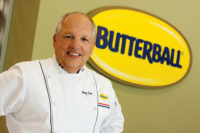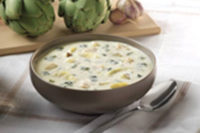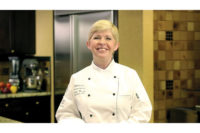Barbecue meats, sauces and flavors: a chef’s perspective
Prepared Foods talks with Andy Husbands, an award-winning chef, author and television personality

SOURCE: KEN GOODMAN PHOTOGRAPHY

There’s been a definite trend of “sweet on sweet” for sauces and rubs, but developers should now anticipate a switch to more sweet and sour, as well as more sweet and spice.
SOURCE: KEN GOODMAN PHOTOGRAPHY

The biggest trend is barbecue “crafting.” That is, a focus on how things are made, what the quality is and where all of the ingredients come from.
SOURCE: KEN GOODMAN PHOTOGRAPHY



Prepared Foods talks with Andy Husbands, an award-winning chef, author and television personality as well as executive chef-owner of the Tremont 647 and Sister Sorel restaurants in Boston.
Prepared Foods: What’s been the greatest flavor-related shift in barbecue?
Andy Husbands: There’s been a definite trend of “sweet on sweet” for sauces and rubs, but developers should now anticipate a switch to more sweet and sour, as well as more sweet and spice, especially the latter.
PF: What do you regard as the biggest overall barbecue trend?
Husbands: The biggest trend is barbecue “crafting.” That is, a focus on how things are made, what the quality is and where all of the ingredients come from. This is especially important as concerns the meat itself. With meat, consumers are interested in how the animals are fed and how the animals were raised, as well as how they are treated. And barbecue product makers have a great opportunity to really lead, develop and have what they make—sold as a crafted product.
PF: How do you see the crafted barbecue trend transitioning to prepared foods and components?
Husbands: Think of barbecue’s origins as a backyard, artisanal product by nature; it’s a cuisine built by necessity, since people had to preserve meat and cook tough cuts. So we could see more of the underutilized “global” cuts of meat successfully utilized.
An example would be ingredients such as lamb necks or pork shanks—cuts that, when prepared right, and boneless or not, will be a great cut to translate to a processed product. It’s an “old school, community-oriented” style of barbecue foods.
PF: Can smoke flavoring replace actual smoke?
Husbands: The quick answer is, “No.” It’s understandable that time is the biggest challenge for production when it comes to barbecued foods. You can’t really—pridefully and honestly—call something “barbecue” and not smoke it and cook it low and slow. You can try to use [smoke flavoring] but really, it still is preferred to smoke the meat.
PF: What about dry rubs versus wet rubs versus marinades and their application for ready-to-barbecue meat and poultry?
Husbands: The standard is still that there are many more dry rubs and marinades than wet rubs. But the trend now is to provide multi-layered flavors, which can come from wet rub pastes. But what’s really trending is using a “reverse rub.” This means rubbing the meat after smoking and cooking. That’s because it can give the product a textural crunch.
On the wet side, adding a little branded sauce, like Tabasco; or sriracha after the cooking is a good method for providing a flavor boost to heat-and-eat barbecue products.
PF: How could food product developers improve the retail barbecue experience?
Husbands: Well, barbecue is and should be gluten free. We’re starting to see more of that, which shows that the trend is affecting even this channel. But I’d also like to see more opt-in meal packages. That is, compartmentalized, modular kits where the consumer can choose a meat, a sauce, a side and combine them themselves. A processor could easily market such a kit in partnership with sides and beverages. This allows consumers to be more active participants. To that end, more par-cooked sides would be welcome.
PF: What’s the greatest technical challenge to product developers when it comes to authentic barbecue foods or components?
Husbands: There’s still a giant disconnect between the top barbecue places and what’s on store shelves. For large-scale producers, what you’re competing against is people’s backyard memories. It’s such a challenge, making an authentic product and at a cost that makes sense as well.
Product developers and processors need to go back to the drawing board and work with the chefs to get more authenticity. The most important prescription I would give is to not overcook the meat. How protein is cooked is a challenge and it seems it nearly always is overcooked in prepared barbecue products. This is especially true of vacuum-packed cooked meat items. One good example is baby back ribs: They should not be cooked FOB [fall of the bone]; they should have some “chew.”
It’s important to look at technology to even just get that “right out of the smoker” quality with the meat. One solution can be a CVAP [controlled vapor] oven. It’s a truly magic oven. I think we’ll be seeing these more and more. It’s a 120?F to 130?F holding oven, but there’s no drying out of the product. It holds and keeps the meat and poultry juicy, yet preserves the texture.
Another key thing is to not over-sauce the finished product. Processors need more subtlety in their sauces and flavors. This can be accomplished by involving more chefs who do barbecue well.
But they can start with the rubs. One of the biggest problems is that most of them are too smoky flavored. Smoke is like salt; it’s a flavor enhancer, it doesn’t need to blow you away. Moreover, smoke flavor can grow within the product.
Also, the earlier mentioned trend of “sweet-on-sweet” sells the American consumer short. Today’s consumer can handle spice, heat and even sour–not just capsaicin but cumin, and other spices and flavor profiles that excite the palate. Any experience, especially a food experience, should lead to the next experience, even if it’s another bite of the same item.
PF: Do you have a final “take-away” for barbecue product developers?
Husbands: Processors should rely on the home preparer or end-user to do a little bit more for a much higher quality product. That’s also where the modular, “kit” concept comes in; it is asking the end-user to do more, but it’s also providing more of the fun part of barbecue.
Looking for a reprint of this article?
From high-res PDFs to custom plaques, order your copy today!








